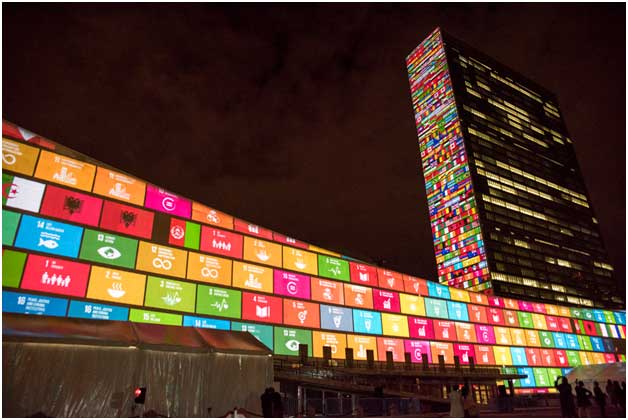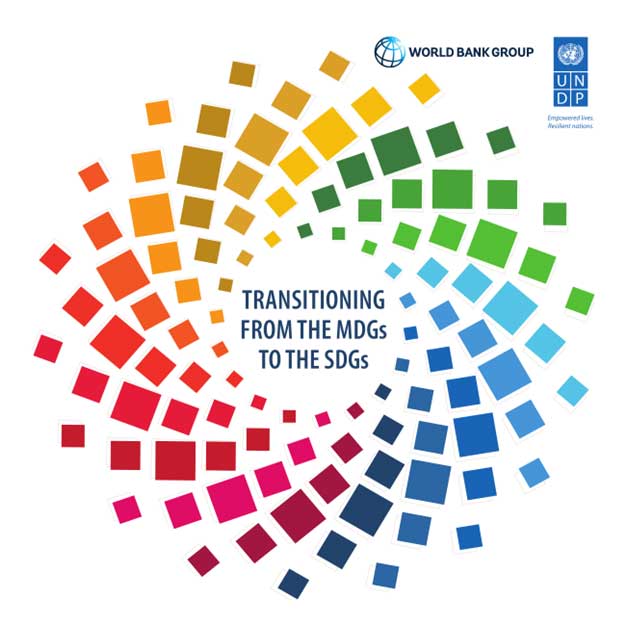Salvaging the SDGs: New Thinking to Spur Action Takes Shape

NEW YORK, Oct 03 (IPS) - For the first time since a new development agenda was adopted in 2015 to make the world a better place for everyone, government leaders assembled at the United Nations in late September to take stock of progress. The verdict of this summit was not good.
The 17 Sustainable Development Goals (SDGs), the centerpiece of Agenda 2030, were on life support in the eyes of many experts in and around the high-level UN sessions. Some goals were in danger of reversing earlier gains.
A new strategy, however, devised by a team of international development experts, was presented for governments to consider to turn around the bad news about the faltering goals.
"Our goal to end extreme poverty by 2030 is being jeopardized as we struggle to respond to entrenched deprivation, violent conflicts and vulnerabilities to natural disasters," Secretary-General António Guterres wrote when the latest data on the SDGs were released in July 2019.
The numbers provided background to the meeting of world leaders in New York during the opening of the 74th General Assembly.
"Global hunger is on the rise, and at least half of the world's population lacks essential health services," Guterres wrote. "More than half of the world's children do not meet standards in reading and mathematics; only 28 per cent of persons with severe disabilities received cash benefits; and women in all parts of the world continue to face structural disadvantages and discrimination.
"It is abundantly clear that a much deeper, faster and more ambitious response is needed to unleash the social and economic transformation needed to achieve our 2030 goals."
Guterres reiterated his message of urgency when he opened the high-level review of the SDGs on Sept. 24. Speaking the next day, Deputy Secretary-General Amina Mohammed was more optimistic about what she saw as "the boundless potential of humanity to create a better future for all." Mohammed, however, who had shepherded the goals into their final form in 2015, acknowledged that progress was off track.
The data report in July revealed that despite some gains, many millions of people among the world's 7.7 billion people were living in shocking conditions. That included the 785 million people without basic drinking water services and three billion people still lacking clean cooking fuels, contributing to poor health.
Fewer than half of the people in the world had access to safe sanitation, and 673 million were forced to defecate in the open, according to the latest statistics from 2017.
"Achieving universal access to even basic sanitation services by 2030 will require a doubling of the current annual rate of progress," the secretary-general has noted.
Separately, a UN special rapporteur on human rights, Urmila Bhoola, reported that more than 40 million people are enslaved worldwide, a quarter of them children, and that the numbers are expected to rise.
More than 60 percent of those in forced labor work in the private sector, with women and girls disproportionately affected. Almost all of them — 98 percent — have experienced sexual violence, said Bhoola, who reports on contemporary forms of slavery.
Against this dismal panorama, a new report emerged with talking points for the gathering of government officials on the SDGs during the UN General Assembly session this month. The report challenged current assumptions and thinking on the planning and implementing of development projects.
Titled "The Future Is Now: Science for Achieving Sustainable Development," the report does not attempt to rewrite the 17 development goals or their mind-numbing 169 targets.
Instead, the authors, a team of 15 experts in social and natural sciences assembled in 2016 from developing and industrial countries, concluded that goals could be interconnected or clustered to promote synergistic exchanges for greater effectiveness and should not be isolated in 17 silos.
Leading the group as co-chairs were Peter Messerli, director of the Center for Development and Environment at the University of Bern in Switzerland, and Endah Murniningtyas, a former deputy planning minister of Indonesia. The UN's Department of Social and Economic Affairs published their report. (For a global projection of how far off the targets are, see https://sustainabledevelopment.un.org/gsdr2019 Table 1-1.)

The scientists recommended six areas that could be collaboratively transformative: issues of human well-being and abilities; sustainable and just economies; sustainable food systems and healthy nutrition; energy decarbonization; urban and peri-urban development; and the global environmental commons. They named four "levers" that could be used to spur action: governance, economy and finance, individual and collective action and science and technology.
The underlying importance of science, including the professional collection of credible data, is a theme that runs throughout the report. Governance is also given prominence in both identifying and implementing the goals.
In "The Future Is Now" report, the scientists appeared to conclude that new thinking was needed.
"Every country and region should design and rapidly implement integrated pathways to sustainable development that correspond to their specific needs and priorities, and contribute also to the necessary global transformation," the authors said.
Using one issue, childhood nutrition, the authors described how their report's "entry points" can be linked: "For instance, changes in food habits towards more healthy diets may result from individual and collective action, which is informed by scientific knowledge that can directly influence choices made by families, while supporting governance initiatives such as mandatory food labelling and schools limiting students access to sugary drinks."
The emphasis on collaboration and interaction within and among countries suggests that the current lack of such links reflects not only failures of governance but also the impetus and structure of the SDGs.
David Malone is the rector of the United Nations University in Tokyo and a former president of Canada's International Development Research Center. He was asked by PassBlue why the SDGs have faltered while the Millennium Development Goals that preceded them were more successful.
"The Millennium Development Goals arose from a desire of the developing continents to refocus the UN on development issues after the decade of the 1990s had focused the UN very much on peace and security," according to Malone, who has been Canada's ambassador to India, Nepal and Bhutan as well as deputy chief of Canada's UN mission.
"They offered the considerable benefit of being simple and clear, few in number (8) with few accompanying targets and indicators," he said in an email response. "They were not developed by member states, but rather in the office of Secretary-General Kofi Annan several months after the Millennium Summit".
"That they were mostly attained owes a great deal to the manageable nature of the package, so to speak. But it probably owes more to a very significant growth spurt in both Asia and Africa and to a strong focus on social development in Latin America between the years 2000 and 2015."
"The members states of the UN very much wished to develop the successor platform, the SDGs, themselves," he added. "The result was a fairly political approach including compromises that were essentially additive — each country's or region's pet priority being somehow accommodated — with little attention to the ability of many governments to implement complex schemes developed internationally".
The SDGs involve 17 goals, 169 targets and over 200 indicators by which those targets can be measured.
"After their adoption, it became clear within two years that many governments, particularly those with limited administrative capacity, while celebrating the goals, were not actually using them in planning or budgeting national priorities. The UN Secretariat has signaled several times now that on current global economic growth trends, many of the SDGs are unlikely to be attained. Politics nationally, regionally and globally are hardly cooperating either. And SDG success is very much hostage to both sets of factors."
A significant difference between the SDGs and the MDGs is that the former should apply to every nation, not only developing countries, and that all governments are expected to declare their aspirations, plan their appropriate policies and track their national progress.
That has not happened in numerous places. One of the most glaring examples is the United States. A State Department website on the topic qualifies it by an advisory that it "is a work in progress" and mostly devoid of US-specific information or commitment.
Among other advanced economies, the Europeans have done much better, with a number of related websites, beginning with an overview of regional policies.
On Sept 24 at the UN, a panel of European Union and developing-country partners in the 79-member African, Caribbean and Pacific Group of States announced a new commitment to the 2030 Agenda, backed by about $32 million, from the Europeans.
Canada, with numerous websites introduced by a comprehensive policy statement, is also active, as is Japan. It has multiple online sites, including one following the work of its national task forces carrying out the sustainable goals.
© Inter Press Service (2019) — All Rights ReservedOriginal source: Inter Press Service
 Global Issues
Global Issues